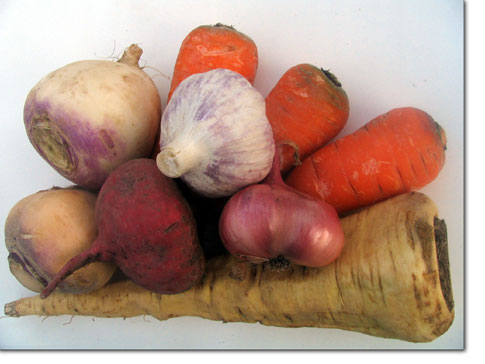| ||
Roasted Root Risotto
by Chef Boy Ari I was sitting in a café sipping hot chocolate. Outside the window, a restless wind blew leaves around the grey afternoon, and the warm cup felt just right in my hands. Autumn is a sweet and savory time, a time when the beauty of life seems all the more dear and fleeting. With me was chef Jason Willenbrock, a master in the field of pairing sweet and savory flavors. His line of spiced chocolate truffles, including such daring flavors as paprika, rosemary and garam masala, pushes the limits of culinary confection – and succeeds brilliantly. Jason was telling me about another dish he’s created that pairs the sweet and savory flavors of the autumn harvest. He calls this earthy dish . Fall is the season of roots. While the above-ground parts of the edible plants we grow start to die, the below-ground portions thrive. When stored properly, roots will last through a winter’s worth of soups, mashes, home fries and roasts. Roasting root vegetables “brings out their sweetness and chases away misconceptions that roots taste bitter,” said Jason, explaining how roasting causes starch to break down into sugar, creating sweetness to complement the roots’ savory earth tones. Start with an even amount of as many of the following roots as you can find: carrot, parsnip, turnip, rutabaga, and beet (yellow or stripped beets work, but not red beets, which will bleed over the whole dish). If the carrots or parsnips are tapered, cut them crosswise in the middle. Rub the roots with olive oil and then with coarse salt and crushed black pepper. Put them in a cast iron skillet or Dutch oven with a lid, or in a tray with foil. Bake at 375 degrees. “Roast them until … until … hmm, this is the tricky part,” said Jason. “The biggest challenge is to not overcook the roots. Perfectly undercooked is perfect – just starting to soften. When pierced with a knife, just a touch of resistance.” Meanwhile, break apart a head of garlic, peel the cloves and put them in a small, oven safe dish covered in olive oil. Place the dish in the oven and roast the garlic until soft. After 20 minutes the parsnips will start to get soft – first the skinny ends, then the fat ends. Next, the skinny ends of the carrots will soften, and so on. As you remove the roots, turn the ones that remain in the pan. With a kitchen towel, grasp the hot roots as they come out of the oven and rub off the skins. When they cool enough to handle with bare hands, cut them into a brunoise. Technically, a brunoise is a finely chopped mixture of individual pieces no larger than one-16th of an inch, cubed. To create it, first make thin slices of the cooked roots, then slice the slices into “matchsticks” or julienne, and then chop the matchsticks into the brunoise. I tried this at home and, well, I need a little more practice. So unless you are trying to pass the cooking school exam, just mince it as finely as you can. “Think of the brunoise as risotto grains,” said Jason. “Like grains of risotto, the root pieces should maintain their individuality and not cook to mush.” When all of your roots are roasted and minced, brown some butter in a pan. Browning butter, not to be confused with burning butter, is an art. Keep the butter moving in the pan, and as soon as it starts to get a hue of brown, remove the heat. It will finish browning with the heat that remains in the pan. Then add some chopped onion or shallot, and some minced garlic, on low/medium heat. When the onions turn translucent, add the brunoise, and stir it around to coat with butter. Then add enough vegetable stock to come about two-thirds of the way up to the top of the buttered roots. I asked, “Can you use chicken stock?” “If you’re not going vegetarian, then chicken stock is ideal because there is more gelatinous material to coat the roots. Otherwise, go for a reduced vegetable stock – I like to use Hen of the Woods mushrooms in mine, it gives that gelatinous quality.” “The real magic happens in the roasting,” reminds Jason. “What happens in the pan is the finale. Nail the roasting and it doesn’t matter what happens in the pan – as long as you don’t make soup!” Stir in some fresh herbs, like thyme, parsley and tarragon. Stir the minced roots until the liquid cooks off. Season with salt and pepper. Mash the roasted garlic, gently fold it into the , and serve. “Serve it with a dollop of rum and maple syrup whipped cream,” suggested the chef. •
|


